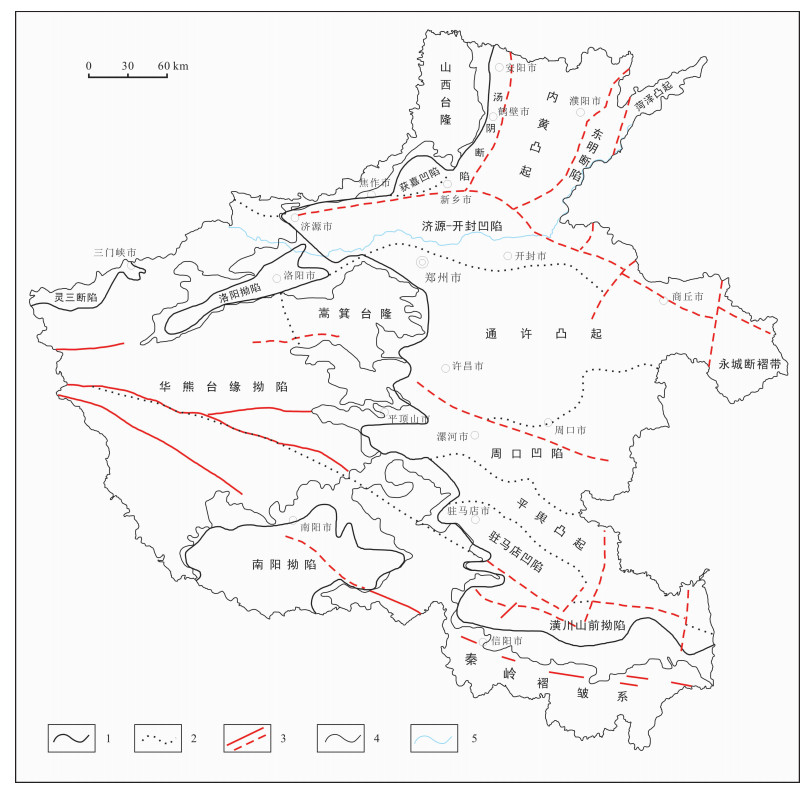GEOTHERMAL GEOLOGICAL CHARACTERISTICS OF FIVE TECTONIC UNITS IN THE SEDIMENTARY BASINS OF HENAN PROVINCE
-
摘要:
河南省沉积盆地区是地热资源的主要赋存区.河南省有11个省辖市市区和60多个县城分布于沉积盆地区五大构造单元内.对五大构造单元524眼地热井研究分析显示,不同构造单元地热井的分布密度不均,地热井的取水段深度相差较大.五大构造单元平均取水段深度为这些地区施工地热井深度确定提供了依据.五大构造单元地热井分布密度统计表明,有三大构造单元地热井分布密度小于0.9眼/100 km2,具有较大的开发空间.
Abstract:The sedimentary basins inside five tectonic units in Henan Province, involving 11 cities and more than 60 counties, is the main areas where geothermal resources occur. Analysis of 524 geothermal wells in the five tectonic units shows that the geothermal wells are unevenly distributed in different units, and the depths of water taking layers in the wells vary greatly. The average water taking depths of the five tectonic units provide a basis for the designing of geothermal wells in these areas. The distribution statistics of geothermal wells in the five tectonic units show that the distribution density in three units is less than 0.9 wells per 100 km2, with great potential for exploration.
-

-
表 1 河南省地热分区表
Table 1. Zonation of geothermal units in Henan Province
地热区 地热亚区 沉降盆地 汤阴断陷 内黄凸起 东明断陷 荷泽凸起 获嘉凹陷 济源-开封凹陷 通许凸起 周口凹陷 永城断陷褶皱带 平舆凸起 驻马店凹陷 潢川山前凹陷 灵宝三门峡断陷 沉降盆地 狢阳拗陷 汝河断陷 南阳拗陷 隆起山地 山西台隆 华熊台缘凹陷 嵩箕台隆 秦岭褶皱系 -
[1] 王现国, 张慧, 张娟娟.开封凹陷区地热水水化学特征及同位素分析[J].安全与环境工程, 2012, 19(6):88-92. http://d.old.wanfangdata.com.cn/Periodical/dzktaq201206018
[2] 李海林.郑州市郑东新区深部地热资源研究[J].地下水, 2011, 33(4):7-10. http://d.old.wanfangdata.com.cn/Periodical/dixs201104003
[3] 王继华.河南沉降盆地地热资源评价[J].长江大学学报(自然科学版), 2010, 7(2):178-180. http://www.wanfangdata.com.cn/details/detail.do?_type=perio&id=QK201001649230
[4] 王心义, 黄丹.河南省地热资源开发利用现状评价[J].地下水, 2010, 32(1):54-55, 70. http://d.old.wanfangdata.com.cn/Periodical/dixs201001022
[5] 王肖凤, 符勇, 康彩艳.南阳盆地地热特征与开发利用前景[J].平顶山学院学报, 2010, 25(2):122-125. http://d.old.wanfangdata.com.cn/Periodical/pdsszxb201002031
[6] 商真平, 姚兰兰.商丘市城区可采地热资源量计算分析[J].人民黄河, 2009, 31(5):62, 64. http://d.old.wanfangdata.com.cn/Periodical/rmhh200905025
[7] 张心勇, 马传明.开封凹陷区地温场特征分析[J].工程勘察, 2009, 37(10):44-49. http://d.old.wanfangdata.com.cn/Periodical/gckc200910010
[8] 齐玉峰.河南省开封凹陷区地热田地热资源分析[J].西南科技大学学报, 2009, 24(3):75-78. http://d.old.wanfangdata.com.cn/Periodical/xngxyxb200903015
[9] 刘传权, 郭克剑.郑州市城区深部基岩层热储特征分析[J].华南地质与矿产, 2008(2):58-61. http://d.old.wanfangdata.com.cn/Periodical/hndzykc200802010
[10] 黄光寿, 郭丽丽, 黄凯.河南省十大温泉地热地质特征[J].地质与资源, 2020, 29(1):91-100. http://manu25.magtech.com.cn/Jweb_dzyzy/CN/abstract/abstract10154.shtml
[11] 张满波, 武秀江, 吴双红.河南省地热资源形势及开发利用潜力分析[J].地下水, 2008, 30(4):45, 70. http://d.old.wanfangdata.com.cn/Periodical/dixs200804015
[12] 齐玉峰, 王现国, 王关杰, 等.开封凹陷区地热资源开发利用与保护[J].地下水, 2007, 29(4):77-79. http://d.old.wanfangdata.com.cn/Periodical/dixs200704028
[13] 郭山峰, 王春晖, 吴祖成.周口市地热资源浅析及水文地质参数计算[J].地下水, 2006, 28(6):32-33. http://d.old.wanfangdata.com.cn/Periodical/dixs200606011
-




 下载:
下载: